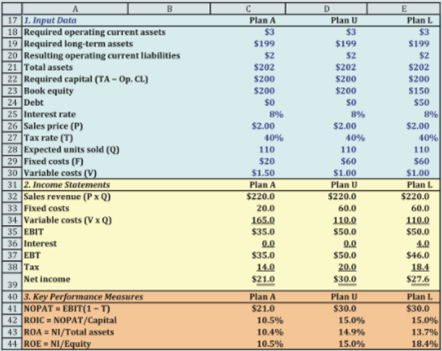Reading: Financial Risk and Financial Leverage
Financial
Risk and Financial Leverage
•Financial
risk is the additional risk placed on the common stockholders as a result of
the decision to finance with debt. Conceptually, stockholders face a certain
amount of risk that is inherent in a firm’s operations—this is its
business risk, which is defined as the uncertainty in projections of future
EBIT, NOPAT, and ROIC.
•If a
firm uses debt (financial leverage), then the business risk is concentrated on
the common stockholders. To illustrate, suppose ten people decide to form a
corporation to manufacture flash memory drives. There is a certain amount of
business risk in the operation. If the firm is capitalized only with common
equity and if each person buys 10% of the stock, then each investor shares
equally in the business risk.
•However,
suppose the firm is capitalized with 50% debt and 50% equity, with five of the
investors putting up their money by purchasing debt and the other five putting
up their money by purchasing equity. In this case, the five debtholders are
paid before the five stockholders, so virtually all of the business risk is
borne by the stockholders. Thus, the use of debt, or financial leverage,
concentrates business risk on stockholders.

•To
illustrate the impact of financial risk, we can extend the Strasburg
Electronics example. Strasburg initially decided to use the technology of Plan
U, which is unlevered (financed with all equity), but now it’s considering
financing the technology with $150 million of equity and $50 million of debt at
an 8% interest rate, as shown for Plan L (recall that L denotes leverage).
•Compare
Plans U and L. Notice that the ROIC of 15% is the same for the two plans
because the financing choice doesn’t affect operations. Plan L has lower net
income ($27.6 million versus $30 million) because it must pay interest, but it
has a higher ROE (18.4%) because the net income is shared over a smaller equity
base.
•When
the quantity sold is 76 million, both plans have an ROIC of 4.8%. The after-tax
cost of debt also is 8%(1 – 0.40) = 4.8%, which is no coincidence. As ROIC
increases above 4.8%, the ROE increases for each plan, but more for Plan L than
for Plan U.
•However,
if ROIC falls below 4.8%, then the ROE falls further for Plan L than for Plan
U. Thus, financial leverage magnifies the ROE for good or ill, depending on the
ROIC, and so increases the risk of a levered firm relative to an unlevered
firm.
Last modified: Tuesday, August 14, 2018, 8:55 AM
